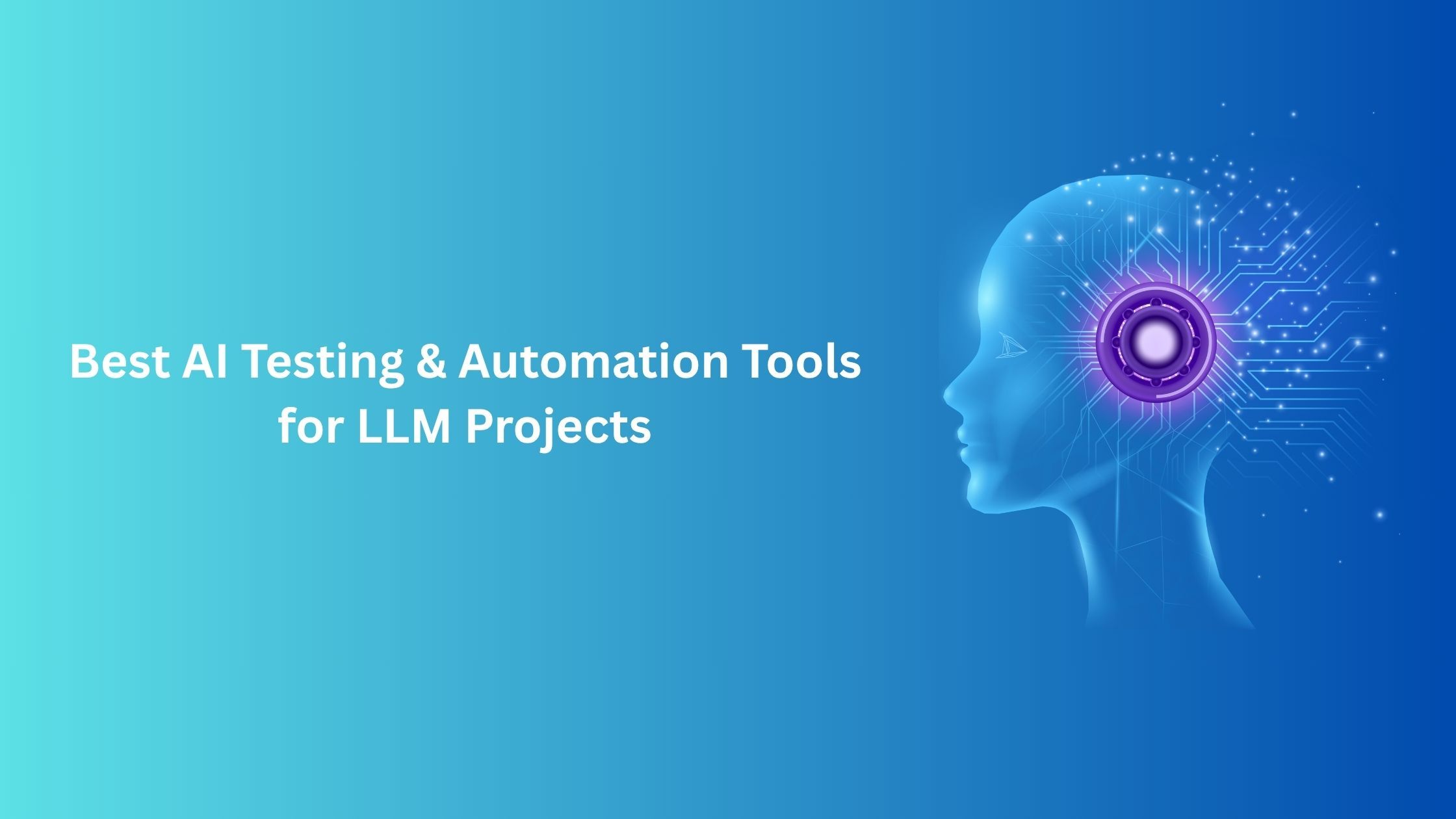Best AI Testing & Automation Tools for LLM Projects

Today LLMs are everywhere, integrated into almost all applications to make work easier. However, ensuring they deliver safe, accurate, and consistent outputs is very critical. This is where AI testing tools and AI testing automation solutions come into play.
But testing LLMs presents a unique, dual challenge. First, there's the task of truly evaluating model behavior. We're talking about measuring how accurate their responses are against what's considered correct, checking for consistency across different tests, and rigorously assessing safety to prevent any harmful or biased outputs.
Secondly, and even more challenging, is the need to automate that evaluation at scale. Doing this manually is simply not feasible for the volume and diversity of tasks LLMs handle.
In this post, we are going to discuss the best AI testing tools and AI testing automation solutions available today to help you build a robust and efficient testing stack for your LLM-powered applications.
What is AI Testing?
AI testing is the application of Artificial Intelligence (AI) technologies, like machine learning and natural language processing, to enhance and automate the software testing process. It focuses on evaluating both traditional software and AI-driven systems (like LLMs), making testing more efficient, accurate, and capable of handling complex and dynamic behaviors.
Best AI Testing & Automation Tools for LLM Projects
To make things easy, we've grouped the best AI testing tools and platforms into three key categories. Think of these as the essential building blocks that, when combined, form the backbone of a modern LLM testing stack. Each category addresses a specific need in AI quality assurance
Category 1: Prompt & LLM Evaluation Tools
These tools are your frontline defense, directly testing or monitoring your LLM's behavior to ensure its outputs are accurate, safe, and aligned with your expectations. They are essential Generative AI testing tools that give you deep insights into how your models are actually performing.
- LangSmith: Developed by the creators of LangChain, LangSmith is a powerful platform designed for debugging, testing, and monitoring AI applications. It's incredibly useful for LLMs as it allows you to trace the execution of your LLM chains step-by-step, helping you quickly identify failures, understand non-deterministic behavior, and improve response quality. LangSmith also offers robust evaluation features, including "LLM-as-Judge" capabilities where an LLM evaluates another's output against predefined criteria, and the ability to gather human feedback. It's also excellent for prompt iteration and comparison, allowing teams to collaborate on and version control their prompts.
Category 2: AI Automation & Orchestration Platforms
While prompt and LLM evaluation tools tell you how well your model is doing at a specific moment, these platforms are the workhorses that automate and orchestrate the AI testing. They automate the testing workflow by triggering prompts, intelligently routing data, storing outputs, applying complex business logic, facilitating human review, and generating comprehensive reports at scale. This comprehensive orchestration is crucial for achieving continuous integration and delivery (CI/CD) for LLM-powered applications, enabling rapid feedback loops and accelerating iteration cycles. These are truly indispensable AI-based test automation tools.
Activepieces: Activepieces operates with "flows," which are essentially automated workflows built by connecting various "pieces" (integrations with other apps and services). Activepieces excels at integrating various AI tools and services, enabling the creation of complex, multi-step validation flows. It supports building sophisticated workflows that leverage different models and AI-powered services.
Here are some examples of how Activepieces enables the orchestration of AI testing workflows
- Test Case Initiation & Prompt Triggering:
- Scheduled Runs: Automatically trigger a set of prompts to your LLM at regular intervals (e.g., daily, hourly) to continuously monitor performance and catch regressions early.
- Event-Driven Testing: Initiate tests based on specific events like a new code commit, a data update in your database, or even a user submitting feedback.
- Batch Processing: Feed a list of prompts from a spreadsheet or database into your LLM for large-scale evaluation.
- LLM Interaction and Output Capture:
- Activepieces integrates directly with various LLM providers (e.g., OpenAI, Anthropic, custom models). You can easily send prompts and capture the generated responses as data within your flow.
- It handles the API calls, allowing you to focus on the testing logic rather than connectivity.
- Applying Evaluation Logic & Criteria:
- After capturing the LLM's output, you can use built-in logic pieces or integrate with external Generative AI testing tools
- Conditional Logic: Set up branches in your flow based on evaluation outcomes. For example, "IF response contains harmful content THEN flag for human review" or "IF response sentiment is negative THEN send alert."
- Data Transformation: Cleanse, reformat, or enrich the LLM's output before it's passed to evaluation tools or storage.
- Metric Calculation: Add code pieces in your automation steps (for advanced users) or pre-built functions to calculate basic metrics on the fly, such as response length, keyword presence, or even simple sentiment scores.
- Storing Outputs and Results:
- Automatically store LLM inputs, outputs, and evaluation results in your preferred data storage solutions like Activepieces tables, Activepieces storage pieces, Google Sheets, databases, data warehouses, or even dedicated logging platforms. This creates a valuable historical record for analysis and auditing.
- This traceability is crucial for debugging and demonstrating compliance over time.
- Human-in-the-Loop Integration:
- Crucially, Activepieces can seamlessly inject human oversight into automated workflows. If a test or an AI-based evaluation flags a potentially problematic response (e.g., high hallucination score, detected bias), the flow can:
- Send for Review: Route the response to a human reviewer via email, Slack, or a dedicated task management tool.
- Await Approval: Pause the workflow until a human provides approval or specific input, ensuring critical decisions have human vetting.
- Collect Feedback: Create forms or chat interfaces to gather nuanced human feedback that can then be used to refine your LLM or training data.
- Crucially, Activepieces can seamlessly inject human oversight into automated workflows. If a test or an AI-based evaluation flags a potentially problematic response (e.g., high hallucination score, detected bias), the flow can:
- Reporting and Notification:
- Generate automated reports on test results, performance trends, and compliance metrics.
- Send real-time alerts to your team on Slack, Microsoft Teams, email, or other communication channels when critical issues (e.g., high error rates, safety violations) are detected.
- Integrate with dashboarding tools to visualize LLM performance over time.
- Build Fallback Flows: Enhance the robustness of your AI applications by creating fallback mechanisms. For example, a user-generated comment is first sent to GPT for initial content generation. If GPT's output triggers a potential safety flag (detected by a keyword check in Activepieces), the flow then sends that content to Claude (a different LLM known for its safety features) for a secondary, more stringent validation. If Claude also flags it, the comment is sent to a human moderator via an email notification. This demonstrates a powerful, multi-agent validation flow, enabled by Activepieces.
Other AI Test Automation & Orchestration Platforms:
- Testim.io: A powerhouse in AI-powered test automation, Testim.io excels at creating tests with little to no code.
- Tosca Copilot: It is designed to automate and optimize test processes specifically for enterprise environments. It's about bringing the power of AI to test asset creation and management, promoting continuous testing practices.
- Mabl, Applitools (visual AI testing), Virtuoso (natural language test automation), Aqua Cloud IO (text-to-tests): These are other strong examples of platforms leveraging AI to automate various aspects of software testing.
Category 3: Data Feedback & Evaluation Tools
LLMs are nuanced and often require human judgment. This category of AI testing tools focuses on managing human feedback, prompt rating, and annotation, creating essential feedback loops that drive continuous improvement for your models. These tools bridge the gap between automated checks and the subjective, qualitative aspects of LLM performance.
- Label Studio: Label Studio is a versatile, open-source data labeling and annotation platform. While widely used for preparing training data across various AI tasks (like computer vision and NLP), it's also incredibly powerful for human feedback and prompt rating for LLMs.It provides a structured, collaborative environment for collecting the precise human feedback needed to fine-tune LLMs, detect subtle biases, and improve subjective aspects of model performance that automated metrics might miss.
- Google Sheets / Airtable: These are widely accessible, flexible spreadsheet and database tools, respectively. While not "AI tools" in themselves, their versatility makes them surprisingly effective for managing prompt ratings and feedback, especially for smaller projects or as a quick starting point. However, they can become cumbersome for very large datasets, complex relational data (though Airtable is better at this than Sheets), or highly dynamic workflows. They lack built-in version control or sophisticated quality assurance features for annotations compared to dedicated labeling platforms. However, for getting started and simple feedback loops, they are great.
- Weights & Biases (W&B), DVC for Experiment Tracking: A comprehensive MLOps platform for experiment tracking, model versioning, and dataset versioning. While it has dedicated LLM evaluation features, its core strength in this category is managing the entire feedback loop and experiment lifecycle. These data feedback and evaluation tools are indispensable for closing the loop in LLM development. They provide the necessary mechanisms to incorporate the invaluable human element into AI testing, ensuring that models are not only technically sound but also aligned with human expectations, ethical considerations, and real-world utility.
The Power of an Integrated AI Testing Stack
AI testing is no longer just about checking model outputs in isolation; it's about building a robust, automated, and continuously evolving pipeline that encompasses every stage of development. So this requires a shift in mindset, to embrace the following:
- Automation: To keep pace with rapid iteration cycles, manual testing is simply unsustainable. Automating prompt triggering, response capture, and initial evaluations is paramount for efficiency and scalability.
- Integration: The best AI testing strategies involve a seamless integration of various specialized tools.
- Iteration: AI models are constantly learning and evolving. Effective testing must facilitate rapid feedback loops, enabling teams to quickly identify issues, refine prompts, retrain models, and deploy improvements.
Each category of tool discussed plays a vital role. These categories aren't meant to be used in isolation; rather, their true power lies in working together as a cohesive testing stack.
Therefore, platforms that enable powerful orchestration play a critical role. Activepieces stands out as a powerful orchestrator in making AI testing scalable, reliable, and friendly for non-technical teams It acts as the connector, allowing diverse tools to work together, simplifying complex workflows, and ensuring that crucial human insights are integrated into the automated pipeline.


